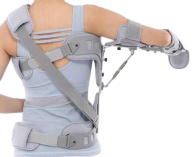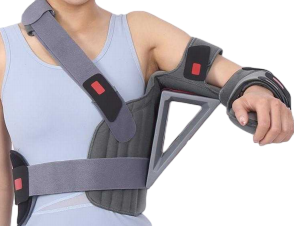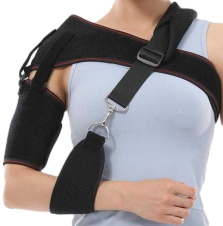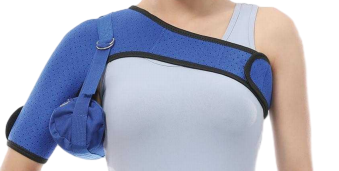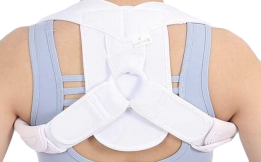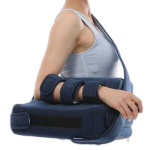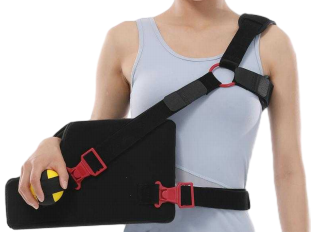Rotator cuff injuries are a prevalent cause of shoulder pain and dysfunction, significantly impacting the quality of life for millions of individuals globally. The rotator cuff, a complex structure comprising four muscles and their tendons, plays a crucial role in stabilizing the shoulder joint and facilitating a wide range of motion. When these tendons are torn, it can lead to severe impairment in daily activities and sports performance. Arthroscopic rotator cuff repair is a widely employed surgical intervention aimed at restoring the integrity of the torn tendons and alleviating pain. However, the success of this surgical procedure is not solely dependent on the surgical technique; postoperative care, particularly the use of abduction braces, plays a pivotal role in the healing process.
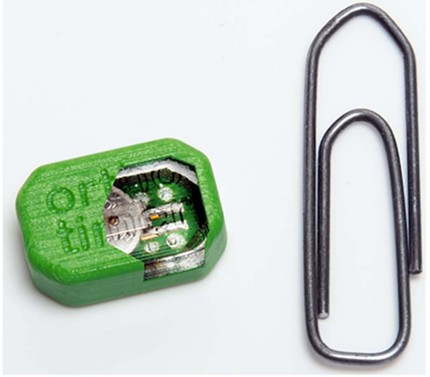 Fig.1 Illustration of the size of the temperature-sensitive sensor. (Grubhofer F., et al., 2022)
Fig.1 Illustration of the size of the temperature-sensitive sensor. (Grubhofer F., et al., 2022)
The Role of Abduction Braces in Postoperative Care
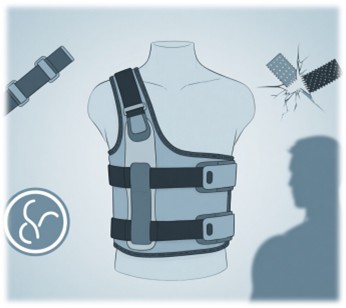
Abduction braces are commonly prescribed to patients following rotator cuff repair surgery. These braces are designed to immobilize the shoulder, reducing tension on the tendon-to-bone repair site and promoting a safer healing environment. The primary goal of using an abduction brace is to prevent excessive movement that could compromise the repair site, thereby enhancing the likelihood of successful tendon healing. Despite the widespread use of abduction braces, the effectiveness of these devices has been a subject of debate, with previous studies yielding inconsistent results. One of the key challenges in evaluating the impact of abduction braces is the lack of objective measures of compliance. Historically, studies have relied on patient self-reports, which are often inaccurate and unreliable.
Objective Measurement of Abduction Brace Compliance

A recent study conducted at the Department of Orthopaedic Surgery, Balgrist University Hospital, University of Zurich, addressed the critical gap in the literature by objectively measuring abduction brace wearing compliance. This study utilized temperature-sensitive sensors embedded in the abduction braces to accurately measure the actual wearing time. Compliance was defined as the percentage of the recommended wearing time (23 hours per day for 6 weeks) that the patients adhered to. This innovative approach provided a more reliable and objective assessment of compliance, allowing for a more accurate evaluation of the impact of brace usage on surgical outcomes.
Study Design and Methods

The study involved 46 consecutive patients who underwent arthroscopic repair of a superior rotator cuff tear. The patients were prospectively analyzed for clinical and radiographic outcomes, with a focus on the impact of objectively assessed abduction brace wearing compliance. The study utilized temperature-sensitive sensors embedded in the abduction braces to measure the actual wearing time. Compliance was defined as the percentage of the recommended wearing time (23 hours per day for 6 weeks) that the patients adhered to. Rotator cuff integrity was assessed using ultrasound, with MRI arthrography performed in cases where a retear was suspected. Clinical outcomes were evaluated using the relative Constant-Murley score (RCS), the Subjective Shoulder Value (SSV), pain ratings, and patient satisfaction scores. The study used Receiver Operating Characteristic (ROC) curves to determine the optimal cutoff value for abduction brace compliance in discriminating between shoulders that would and would not experience a retear.
Key Findings and Statistical Analysis
The study found that patients with a compliance rate of less than 60% had a 13-fold higher risk of rotator cuff repair failure compared to those with a compliance rate of 60% or higher. The retear rate was significantly higher in the low-compliance group (27%) compared to the high-compliance group (3%). Notably, the two patients with the lowest compliance rates (11% and 22%) both experienced retears. Despite these findings, there were no significant differences in RCS, SSV, pain, or postoperative patient satisfaction between the high- and low-compliance groups. The study used ROC curves to determine a cutoff value of 60% compliance for discriminating between the intact and retear groups, with a sensitivity of 81% and a specificity of 75%. The area under the curve was 0.747, indicating a moderate level of discrimination.
Subgroup Analysis: Compliance and Retear Rates
The study's subgroup analysis revealed that patients with retears had significantly lower mean absolute wearing time and compliance rates compared to those without retears. The clinical outcomes were also worse in the retear group, with lower RCS and patient satisfaction scores. Interestingly, three out of the four patients with retears were smokers, suggesting a potential link between smoking and compliance issues. The study's findings underscore the importance of adherence to postoperative immobilization protocols in rotator cuff repair. A compliance rate of less than 60% was associated with a significantly higher risk of retear, highlighting the need for better patient education and support to ensure proper brace usage.
Clinical Implications and Future Directions

The study's findings have significant clinical implications for the management of patients undergoing rotator cuff repair. The results highlight the importance of adherence to postoperative immobilization protocols, suggesting that compliance with abduction brace usage is a critical factor in the success of rotator cuff repair surgery. The study's limitations, including the small sample size and short follow-up duration, suggest the need for larger, prospective trials to confirm these findings. Future research should also explore the impact of other factors, such as smoking and obesity, on compliance and healing outcomes. Additionally, the development of more advanced compliance monitoring technologies could provide further insights into the effectiveness of postoperative care protocols.
Conclusion
The study conducted at the University of Zurich represents a significant advancement in understanding the role of abduction brace compliance in rotator cuff repair outcomes. By using objective measures of compliance, the study provides valuable insights into the importance of adhering to postoperative immobilization protocols. While the findings are promising, further research is needed to fully understand the complex interplay between compliance, patient factors, and surgical outcomes. For now, the study serves as a reminder to both patients and healthcare providers of the critical role that compliance plays in the success of rotator cuff repair surgery.
If you have related needs, please feel free to contact us for more information or product support.
Reference
- Grubhofer, Florian, et al. "Effect of abduction brace wearing compliance on the results of arthroscopic rotator cuff repair." JBJS Open Access 7.2 (2022): e21.
These products and services are for research use only and cannot be used for any clinical purposes!



 Fig.1 Illustration of the size of the temperature-sensitive sensor. (Grubhofer F., et al., 2022)
Fig.1 Illustration of the size of the temperature-sensitive sensor. (Grubhofer F., et al., 2022)



